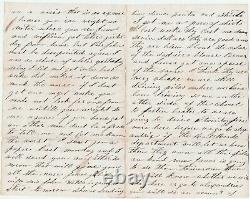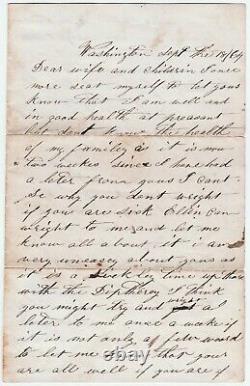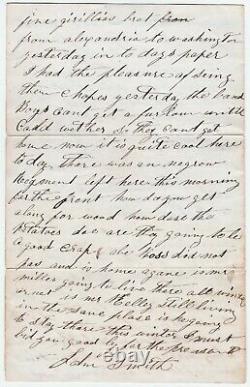Civil War Letter Soldier 1864 Black Regiment Sickness Wife w another man 4p




Interesting Original Civil War Letter. To wife : if you have got another man don't be afraid to tell me...
Sent back home to Mannsville - Jefferson County, NY. For offer, a rare letter! Fresh from a prominent estate in Upstate NY. Never offered on the market until now. Vintage, Old, Original, Antique, NOT a Reproduction - Guaranteed!
This letter was found in some papers I bought from a local estate. The writer talks about a lot of different things, including sickness, a negro regiment that left in the morning, diphtheria, complains about not getting a letter, asks wife if she has found another man, talks about driving piles, railroad, river, going to Alexandria, guerilla fighters captured, , etc. Signed by soldier John Smith.
Have not done research to try to figure out who he was. Other letters in the collection (which were not Civil War related) were sent to Mannsville, Jefferson County, NY, so he probably was a NY volunteer from that area. 4 pages of autograph manuscript writing, signed by Smith. Spelling is not the best, but legible. He uses the word yous often. A few small areas of light archival reinforcements where folds starting to separate a bit.If you collect 19th century Americana history, American military, African American related, etc. This is a treasure you will not see again!
Add this to your image or paper / ephemera collection. Important genealogy research importance too. The Communities Of New York And The Civil War.
Artillery: 1C, 8L, 10F, 14K. Artillery: 1D, 10K-M, 28th Independent Battery. Cavalry: 1(Veteran)ABL, 20D.
Artillery: 10HIL, 20th Independent Battery. Artillery: 10LM, 28th Independent Battery. Artillery: 1CDH, 2L, 10AHKL, 13A-CI, 14C-EHILM, 16ACF, 20th and 28th Independent Batteries.
Cavalry: 2B, 6E, 11H, 13HI, 18HLM, 20B-DGKM, 25H. Artillery: 1C, 5M, 10D, 14K. Mannsville is a village in the town of Ellisburg in Jefferson County, New York, United States. The population was 354 at the 2010 census, [3] down from 400 at the 2000 census. The name is from Barzillian Mann, early developer. Mannsville is in the southeast part of Ellisburg and is south of Watertown.The community was first settled around 1801. Mannsville incorporated as a village in 1879.
In 1885, a fire burned several structures in the small village, but they were soon rebuilt. In the 1830s missionaries served the area. The Mannsville Methodist - Episcopal Church was organized in 1847 with Rev. Fuller serving as the first pastor. [4] The building was erected in 1859.The parsonage, located three houses east, was built in 1880. In 1957 a large addition was built, and the sanctuary was remodeled in 1967. A new steeple was erected in 2002 with funds provided by Ethel S.
Joyner, and work done by Graves Construction. The first school building in the community was a little red schoolhouse built in 1826, at the intersection of Balch Place and current Route 11.
[4] A second larger two-story building was built on Lorraine Street, but burned in 1878. The third school, built on the foundation of the Lorraine street building, burned in January 1883.
A new building was dedicated in September 1883. There were 106 students in three departments. The schoolhouse again burned in 1907. A new two-story building was completed in 1908, and is currently known as the Mannsville Manor Elementary School.The cement blocks were made to resemble stone. Of Adams was the builder. Classes ran from first to eighth grades.
The district centralized in 1930 with other districts in the towns of Ellisburg and Lorraine. In the early 1930s, six village men held a meeting in the old Club House on Mill Street in Mannsville. [5] With a dollar each, the Mannsville Volunteer Fire Department was established. In 1949 they became incorporated and merged with Pierrepont Manor to become the Mannsville Manor Fire Department, or tongue in cheek as the "Cellar Savers". This was the beginning of Rescue 48. In May 1976, Rescue 48 was reorganized with 25 active members supplying 24-hour ambulance service. The Mannsville Manor Rescue Squad observed their 30th anniversary in 1990. On January 4, 1991, the Rescue Squad became one of the first volunteer paramedic ambulance services in Jefferson County.The Pierrepont Manor Complex was listed on the National Register of Historic Places in 1977. Jefferson County is a county on the northern border of the U.
As of the 2010 census, the population was 116,229. [1] Its county seat is Watertown. [2] The county is named after Thomas Jefferson, third President of the United States of America. [3] It is adjacent to Lake Ontario, southeast from the CanadaUS border of Ontario. Jefferson County comprises the Watertown-Fort Drum, NY Metropolitan Statistical Area.
In 2014 it elected Colleen M. O'Neill as the first woman county sheriff in the state. She had served with the New York State Police for 32 years.
[4] The popularity of the area as a summer tourist destination results in a dramatic increase of population during that season. The United States Army's 10th Mountain Division is based at Fort Drum. The base had a total population of nearly 13,000 according to the 2010 census. When counties were established in the Province of New York in 1683, the present Jefferson County was part of Albany County. This was an enormous county, including the northern part of New York State as well as all of the present State of Vermont and, in theory, extending westward to the Pacific Ocean. This county was reduced in size on July 3, 1766 by the creation of Cumberland County, and further on March 16, 1770 by the creation of Gloucester County, both containing territory now in Vermont. On March 12, 1772, what was left of Albany County was split into three parts, one remaining under the name Albany County. One of the other pieces, Tryon County, contained the western portion (and thus, since no western boundary was specified, theoretically still extended west to the Pacific). The eastern boundary of Tryon County was approximately 5 miles (8.0 km) west of the present city of Schenectady, and the county included the western part of the Adirondack Mountains and the area west of the West Branch of the Delaware River. The area then designated as Tryon County now includes 37 counties of New York State. The county was named for William Tryon, colonial governor of New York. In the years subsequent to 1776, most of the Loyalists in Tryon County fled to Canada.In 1784, following the peace treaty that ended the American Revolutionary War, the name of Tryon County was changed to Montgomery County to honor the general, Richard Montgomery, who had captured several places in Canada and died attempting to capture the city of Quebec, replacing the name of the hated British governor. In 1789, the size of Montgomery County was reduced by the creation of Ontario County from Montgomery. The area split off from Montgomery County was much larger than the present county, as it was later divided to form the present Allegany, Cattaraugus, Chautauqua, Erie, Genesee, Livingston, Monroe, Niagara, Orleans, Steuben, Wyoming, Yates, and parts of Schuyler and Wayne counties. In 1791, Herkimer County was one of three counties split off from Montgomery (the other two being Otsego, and Tioga County).
This was much larger than the present county, however, and was reduced by a number of subsequent splits. The first one of these, in 1794, produced Onondaga County. This county was larger than the current Onondaga County, including the present Cayuga and Cortland Counties, and part of Oswego County. Oneida County (as well as a part of Chenango County), was split off from Herkimer County in 1798. Jefferson County was split off from Oneida County in 1805.In 1817, Carleton Island, captured from the British in the War of 1812, was annexed to the county. During the late eighteenth and nineteenth centuries, the county was largely developed for agriculture. By the early 20th centuries, Watertown was a city with the highest per capita number of millionaires in the United States.
Local industrialists had made early fortunes from industries driven by water power. Mills were established along the falls of the Black River from the first half of the nineteenth century. In 2019, Jefferson County and much of the rest of the North Country was identified as one of the most politically tolerant communities in America, according to an analysis by PredictWise. The American Civil War (also known by other names) was a civil war in the United States from 1861 to 1865, fought between northern states loyal to the Union and southern states that had seceded to form the Confederate States of America. [e] The civil war began as a result of the unresolved controversy of the enslavement of black people and its disputed continuance. War broke out in April 1861 when secessionist forces attacked Fort Sumter in South Carolina, just over a month after Abraham Lincoln had been inaugurated as the president of the United States. The loyalists of the Union in the North, which also included some geographically western and southern states, proclaimed support for the Constitution. They faced secessionists of the Confederate States in the South, who advocated for states' rights to uphold slavery.States in February 1861, seven Southern slave states were declared by their state governments to have seceded from the country, and the Confederate States of America was organized in rebellion against the U. The Confederacy grew to control at least a majority of territory in eleven states, and it claimed the additional states of Kentucky and Missouri by assertions from native secessionists fleeing Union authority.
These states were given full representation in the Confederate Congress throughout the Civil War. The two remaining slave states, Delaware and Maryland, were invited to join the Confederacy, but nothing substantial developed due to intervention by federal troops. The Confederate states were never diplomatically recognized as a joint entity by the government of the United States, nor by that of any foreign country. [f] The states that remained loyal to the U.
Were known as the Union. [g] The Union and the Confederacy quickly raised volunteer and conscription armies that fought mostly in the South for four years. Intense combat left between 620,000 and 750,000 soldiers dead, [14] along with an undetermined number of civilians. [h] The Civil War remains the deadliest military conflict in American history, [i] and accounted for more American military deaths than all other wars combined until the Vietnam War. The war effectively ended on April 9, 1865, when Confederate General Robert E.Lee surrendered to Union General Ulysses S. Grant at the Battle of Appomattox Court House. Confederate generals throughout the Southern states followed suit, the last surrender on land occurring June 23.
Much of the South's infrastructure was destroyed, especially its railroads. The Confederacy collapsed, slavery was abolished, and four million enslaved Black people were freed. The war-torn nation then entered the Reconstruction era in a partially successful attempt to rebuild the country and grant civil rights to freed slaves.
The Civil War is one of the most studied and written about episodes in U. History, and remains the subject of cultural and historiographical debate. Of particular interest are the causes of the Civil War and the persisting myth of the Lost Cause of the Confederacy. The American Civil War was among the earliest industrial wars. Railroads, the telegraph, steamships and iron-clad ships, and mass-produced weapons were employed extensively. The mobilization of civilian factories, mines, shipyards, banks, transportation, and food supplies all foreshadowed the impact of industrialization in World War I, World War II, and subsequent conflicts. The practice of slavery in the United States was one of the key political issues of the 19th century.Slavery had been a controversial issue during the framing of the Constitution, but the issue was left unsettled. [17] On the eve of the Civil War in 1860, four million of the 32 million Americans were black slaves. The flag of the Union. In the 1860 presidential election, Republicans, led by Abraham Lincoln, supported banning slavery in all the U.
Territories parts of the U. The Southern states viewed this as a violation of their constitutional rights, and as the first step in a grander Republican plan to eventually abolish slavery. The three pro-Union candidates together received an overwhelming 82% majority of the votes cast nationally: Republican Lincoln's votes centered in the north, Democrat Stephen A. Douglas' votes were distributed nationally and Constitutional Unionist John Bell's votes centered in Tennessee, Kentucky, and Virginia. The Republican Party, dominant in the North, secured a plurality of the popular votes and a majority of the electoral votes nationally; thus Lincoln was elected president.He was the first Republican Party candidate to win the presidency. The South was outraged, and before his inauguration, seven slave states with cotton-based economies declared secession and formed the Confederacy. The first six to declare secession had the highest proportions of slaves in their populations, with an average of 49 percent.
[19] Of those states whose legislatures resolved for secession, the first seven voted with split majorities for unionist candidates Douglas and Bell (Georgia with 51% and Louisiana with 55%), or with sizable minorities for those unionists (Alabama with 46%, Mississippi with 40%, Florida with 38%, Texas with 25%, and South Carolina, which cast Electoral College votes without a popular vote for president). Eight remaining slave-holding states continued to reject calls for secession. Outgoing Democratic President James Buchanan and the incoming Republicans rejected secession as illegal. Lincoln's March 4, 1861, inaugural address declared that his administration would not initiate a civil war.Speaking directly to the "Southern States", he attempted to calm their fears of any threats to slavery, reaffirming, I have no purpose, directly or indirectly to interfere with the institution of slavery in the United States where it exists. I believe I have no lawful right to do so, and I have no inclination to do so. [21] After Confederate forces seized numerous federal forts within territory claimed by the Confederacy, efforts at compromise failed and both sides prepared for war. The Confederates assumed that European countries were so dependent on "King Cotton" that they would intervene, [22] but none did, and none recognized the new Confederate States of America. Confederate flag, the "Stars and Bars".
Hostilities began on April 12, 1861, when Confederate forces fired upon Fort Sumter. While in the Western Theater the Union made significant permanent gains, in the Eastern Theater, the conflict was inconclusive during 18611862. In September 1862, Lincoln issued the Emancipation Proclamation, which made ending slavery a war goal. [23] To the west, the Union destroyed the Confederate river navy by summer 1862, then much of its western armies, and seized New Orleans.
The successful 1863 Union siege of Vicksburg split the Confederacy in two at the Mississippi River. Lee's Confederate incursion north ended at the Battle of Gettysburg. Western successes led to Ulysses S. Grant's command of all Union armies in 1864.
Inflicting an ever-tightening naval blockade of Confederate ports, the Union marshaled resources and manpower to attack the Confederacy from all directions, leading to the fall of Atlanta to William Tecumseh Sherman and his march to the sea. The last significant battles raged around the Siege of Petersburg. Lee's escape attempt ended with his surrender at Appomattox Court House, on April 9, 1865. While the military war was coming to an end, the political reintegration of the nation was to take another 12 years, known as the Reconstruction era. The item "Civil War Letter Soldier 1864 Black Regiment Sickness Wife w another man 4p" is in sale since Tuesday, February 9, 2021.This item is in the category "Collectibles\Militaria\Civil War (1861-65)\Original Period Items\Correspondence, Mail". The seller is "dalebooks" and is located in Rochester, New York.
This item can be shipped worldwide.- Modified Item: No
- Country/Region of Manufacture: United States
- Theme: Militaria
- Original/Reproduction: Original
- Conflict: Civil War (1861-65)
- Featured Refinements: Civil War Letter

